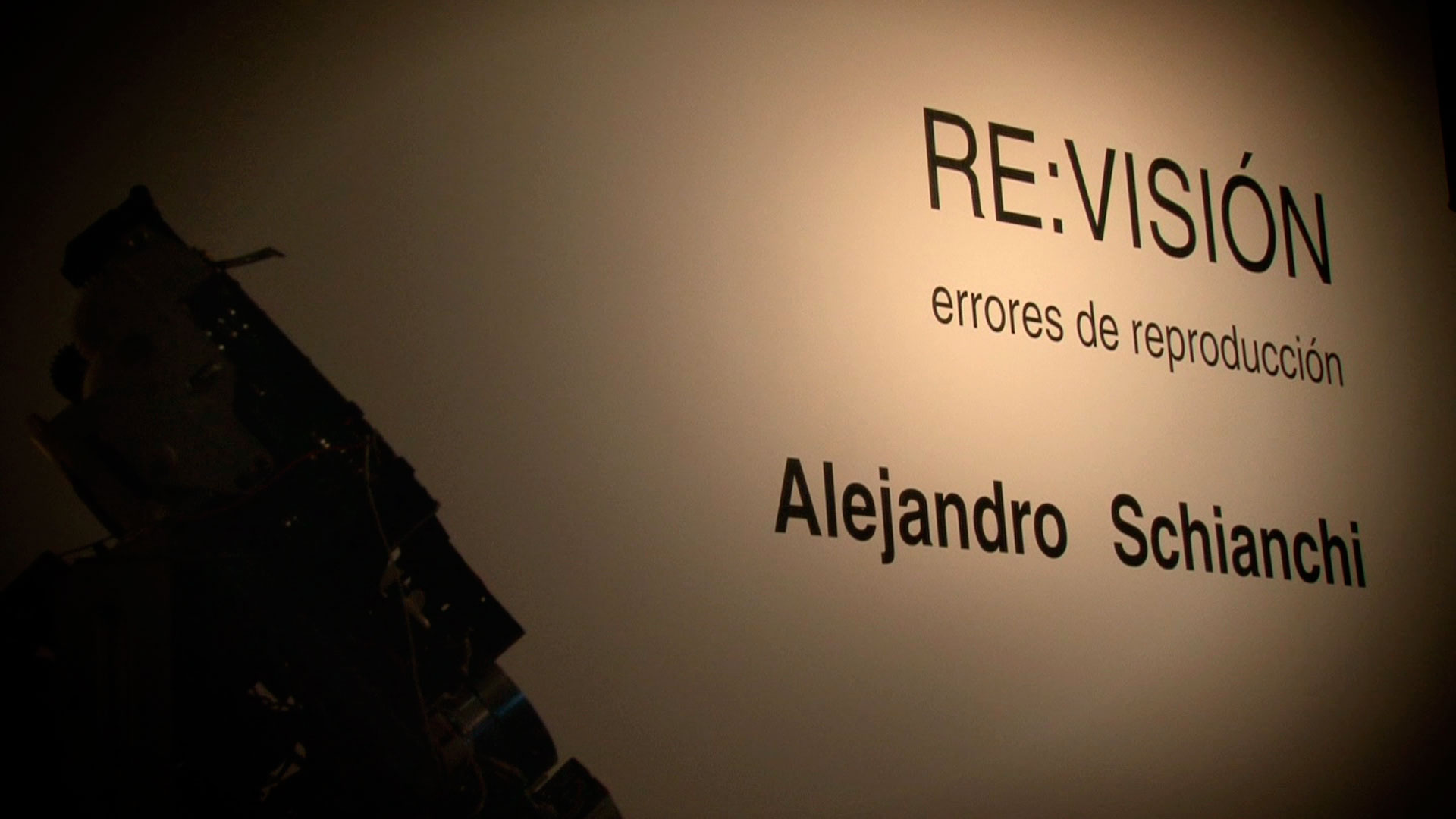Curador: Jorge Zuzulich
Del 1 de Septiembre al 14 de Octubre de 2011.
La muestra consiste en una serie de trabajos en fotografía, fílmico, video (analógico y digital), video objeto, instalación, y realidad aumentada realizados por Alejandro Schianchi durante los últimos diez años. Las obras reunidas presentan un carácter conceptual vinculado a la manipulación de la luz y la imagen en diferentes soportes tecnológicos.
The image (de)ciphered
We live in a world of images. This statement is not new. Such proposition might be evaluated from a Platonic perspective assuming the negative and illusive character of an existence that goes by marked by appearances, at the expense of a real world fully configured by the intelligible, that is, ideas.
In the contemporary context, though, this world of images means, specifically, the technical configuration of said images. The first device to relieve the artist from manual reproduction in the support medium has been photography. Afterwards, in a violent escalation: cinema, television, video, and finally, the digital image. It is a journey marked by the image-building possibilities that are inscribed in the logic of the technical apparatus, which goes from photochemical sensitivity (photography) to mathematical algorithm (digitality), including projection and movement (cinema) to the electronic signal (TV / video).
And this is how the technical image, the one that permanently accompanies us, started from an elusion: the one belonging to its own production mechanism). Vilem Flusser coined a term that accurately characterizes such dynamics: the black box. That place unknown to the majority but whose centrality is based on being the place where the image forms itself. A process holding a logic of artifactual, machinic look, independent from that of the one who poses the eye on the camera’s viewfinder.
From another perspective, Zizek relates this negation of the device with a strictly postmodern logic which constructs a universe that is experienced without questionings in relation to that “beyond the screen.”
Perhaps the production of Alexander Schianchi nucleated in Re: Vision (reproduction errors), is sustained by the breath Flusser himself breathes into a contemporary art which focuses its display in the deconstruction of the core denied of the technical device itself.
This, then, is about that what was hidden may see the light, to evidence the image ciphering mode. To allow the becoming of a kind of image that is away from any idealized sense, (in order) to arrive at another one that shows its deep sense denied in postmodern superficiality. To do this, Schianchi moves along this critical path appropriating several devices: photography, cinema, video, digital.
But also, this abundance of image technical reproduction modes, involves redefining the image in connection with a long standing discussion. Where Benjamin believed that technical reproducibility was the ultimate cause of the crushing of the aura, the here and now that supported the original notion, Schianchi proposes, from his works, to understand the reproductible as a placed copy, and in such a displacement, to restore a certain auratic sense to technical image now deciphered.
Jorge Zuzulich
La imagen (des)cifrada
No es novedosa la siguiente aseveración: vivimos en un mundo de imágenes. La proposición podría ser evaluada desde una perspectiva platónica dejando por sentado el carácter ilusorio y negativo de una existencia que transcurre signada por las apariencias, en desmedro de un mundo real y pleno configurado por lo inteligible, es decir, por las ideas.
Pero, en el contexto contemporáneo, este mundo de imágenes significa, específicamente, configuración técnica de las mismas. El primer dispositivo en relevar al artista de la inscripción manual en el soporte ha sido la fotografía, luego, en un violento escalonamiento: el cine, la televisión, el video y, por último, la imagen digital. Se trata de un recorrido signado por las posibilidades de construcción de imagen que aparecen inscriptas en la propia lógica del aparato técnico, el cual se despliega desde la sensibilidad fotoquímica (fotografía) al algoritmo matemático (digitalidad), pasando por la proyección y el movimiento (cine) a la señal electrónica (TV / video).
Y es así como la imagen técnica, aquella que nos acompaña permanentemente, se constituyó a partir de una elusión: la de su propio mecanismo de producción. Vilem Flusser acuñó un término que caracteriza con exactitud esta dinámica: la caja negra. Ese lugar desconocido para la gran mayoría pero cuya centralidad se sustenta en ser el lugar de constitución de la propia imagen. Proceso que sostiene una lógica de la mirada artefactual, maquínica, independiente de la de aquel que posa el ojo en el visor de una cámara.
Desde otra perspectiva, Zizek relaciona esa negación del dispositivo con una lógica estrictamente posmoderna constructora de un universo que se experimenta sin cuestionamientos en relación con ese “más allá de la pantalla”.
Tal vez, la producción de Alejandro Schianchi nucleada en Re:visión (errores de reproducción), se sustente en el aliento que el propio Flusser insufla a un arte contemporáneo que centre su despliegue en la deconstrucción del núcleo negado del propio dispositivo técnico.
Se trata, entonces, de que aquello que permaneció oculto vea la luz, de evidenciar el modo de ciframiento de la imagen. Permitir, entonces, que devenga un tipo de imagen alejada de todo sentido idealizado para arribar a otra que delate su profundo sentido negado en la superficialidad posmoderna. Para ello, Schianchi realiza este recorrido crítico apropiándose de diversos dispositivos: fotografía, cine, video, digital.
Pero, además, esta profusión de modalidades de reproducción técnica de la imagen implica una redefinición en relación con una discusión de larga data. Allí donde Benjamin creyó ver en la reproductibilidad técnica la causa última de la trituración del aura, del aquí y ahora que sustentaba la noción de original, Schianchi propone, a partir de sus obras, entender lo reproductible como copia situada y, en ese desplazamiento, restituirle cierto sentido aurático a la imagen técnica ahora descifrada.
Jorge Zuzulich
Video documentación realizada por Mundo UNTREF.
Dossier con texto curatorial e información de las obras

